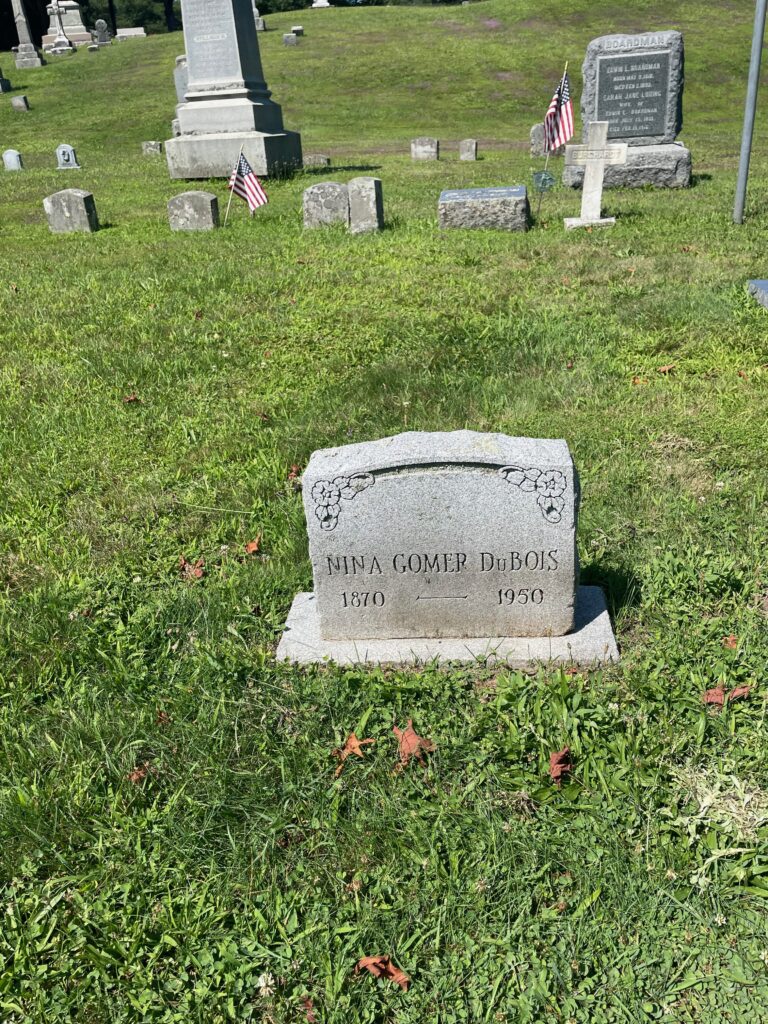Erik Visits an American Grave, Part 1,829
This is the grave of Nina Gomer DuBois.

Born in 1870 in Quincy, Illinois, Nina Gomer grew up in Cedar Rapids, Iowa. Her father was a cook at a local hotel, just about the best job a Black man could get in that time, even in the North. He became head cook and they even bought their own home. She got to attend college too, at Wilberforce, the pioneering Black school in Ohio.
While there, she met a teacher named W.E.B. DuBois. He was still early in his career but already becoming a legendary figure in the fight for Black justice. I do not know if their relationship started while she was a student, but they married in 1896. So she was 26 and he was 28, so in that sense, entirely respectable. She was a smart, committed woman in her own right. But DuBois, like Booker T. Washington and Martin Luther King and Malcolm X and Thurgood Marshall and most of the men who we remember from our civil rights history, had a pretty traditional set of gender beliefs. These guys all pretty much thought women should be staying at home or engaged in support actions, such as typing speeches and making coffee, instead of engaging in real leadership themselves. So it was with DuBois and Nina. Basically, while he was on the road co-founding the NAACP or writing books such as The Souls of Black Folk and Black Reconstruction and so many of the other great books of Black history, she was raising their daughter Yolande.
Nina DuBois’ major contribution to the public record was being part of the Women’s International Circle of Peace and Foreign Relations, which organized the fourth Pan-African Congress in New York in 1927. She and her husband were pretty strict parents to a daughter who really rejected that. In fact, they sent her to boarding school because of her behavior. I think Yolande is buried here too, but I didn’t have a record of it–her own daughter is buried her though as are other extended members of the DuBois family. She continued to resist her parents wishes, though it seems to have been her father who was the real tyrant. She was dating Jimmie Lunceford, the great saxophonist. But the idea of a civil rights leader’s daughter marrying a jazz musician was disgusting to a snob like DuBois (and he was very much a snob). He basically forced her to marry Countee Cullen, who was considered more respectable. That only lasted a short time before she left him. She continued to demand her independence. It seems that Nina had more sympathy with Yolande than W.E.B. did, as she lived with her daughter for quite a few years. In fact, I strongly question just how good the marriage was between Nina and DuBois given how often he was gone and how often she seems to have lived with her daughter after the latter became an adult.
Also, DuBois was by his own admission a terrible husband. He would claim to be a good provider, but admitted that his family were “incidents” in his his “main life’s work.” This is sadly not uncommon among the history of the leading men of the Black freedom struggle–King and Malcolm were pretty bad toward the women and families in their lives too. There is something to this–Dolores Huerta for example basically abandoned her children more or less in order to work full time on the farmworkers movement. So perhaps there’s something a bit inevitable here, though to be fair, Ida Wells used her activism after her kids were born to open a Black kindergarten in Chicago and Bob Moses used his outrage over the lack of math in his daughter’s basically Jim Crow level Boston public school by starting the Algebra Project. In any case, DuBois treated Nina pretty bad, or at least with a sense of complete indifference. He certainly 100% expected and demanded that she stay home and do domestic work. He also cheated on her left and right. As one historian said, she was “practically invisible by the late twenties.”
Nina DuBois died in 1950, at the age of 80.
Nina DuBois is buried in Mahaiwe Cemetery, Great Barrington, Massachusetts. The idea was for her husband to be buried with her. But that didn’t happen. Although old, he still had a long time to live and it would be an eventful thirteen more years that included him becoming a full fledged Communist and leaving the United States to live in the newly free nations of Africa, where he could finally escape the horrors of being Black in the United States. So unless the LGM reader community is ready to send me to Accra, this is as close to a DuBois post as this series is going to get. Though Ghana is on my travel very short list so maybe I will finally get over there in the next five years or so and if I do, I will absolutely visit DuBois’ grave.
If you would like this series to visit other Black women involved in civil rights, you can donate to cover the required expenses here. Daisy Bates is in Little Rock, Arkansas and Dorothy Height is in Brentwood, Maryland. Previous posts in this series are archived here and here.


